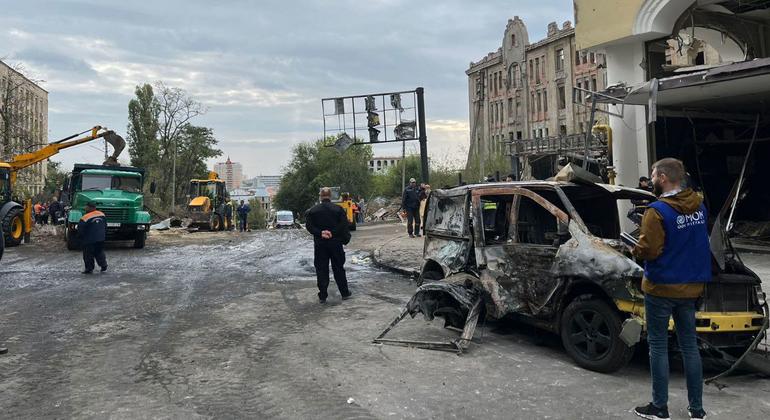The attacks occurred in the city’s Novobovarskyi district late on Thursday. At least three people were killed and a further 16 injured, according to media reports.
The repeated missile strikes caused significant damage to residential buildings. They also affected rescue workers rushing to the scene.
In a statement issued on Friday, UN Humanitarian Coordinator for Ukraine, Denise Brown extended her deepest condolences “to the families impacted by the non-stop attacks by the Russian Federation’s Armed Forces.”
Humanitarian response hampered
Kharkiv, Ukraine’s second largest city, has come under relentless shelling in recent weeks. UN agencies have been assisting in evacuating people from other areas of the wider Kharkiv region that have come under attack.
Ms. Brown said the escalation of hostilities in Kharkiv and elsewhere in Ukraine continues to devastate the lives of families, making humanitarian response efforts even more critical and difficult.
“International humanitarian law strictly prohibits attacks on civilians or civilian infrastructure,” she said.
“Living in fear of air strikes at home, at work or while shopping is not normal.”
Violations against children
Ms. Brown heads the UN Office in Ukraine which issued a separate statement on Friday condemning the severe violations of children’s rights in the wake of the full-scale Russian invasion in February 2022.
Heavy hostilities continue to inflict immense physical, psychological, and emotional harm on children, disrupting their lives and jeopardizing their future.
“The most recent wave of Russian attacks in the Kharkiv Region underscores the dreadful cost of the war, and the horrors that the children of Ukraine are facing,” Ms. Brown said.
“Many have been killed or injured, and thousands forced to flee from their homes with nothing but the clothes on their backs and the profound stress from having witnessed a truly terrifying situation.”
Young lives ended
Over 600 children have been killed, and more than 1,420 injured, since the escalation, according to the UN human rights office, OHCHR, though the actual toll is likely much higher.
The statement said children spend countless hours in bomb shelters due to indiscriminate attacks. Boys and girls in frontline communities have spent between 3,000 and 5,000 hours underground – equivalent to four to seven months – making their lives stressful and extremely difficult.
Forced displacement further compounds dangers they face, including separation from their families and increased risks of trafficking, exploitation and abuse.
A four-year-old girl shelters at her kindergarten in the Kharkiv region of Ukraine.
Education and healthcare disrupted
The war has also severely affected education, and many schools have adopted online or underground classes. The UN Office in Ukraine expressed particular concern over the situation of children in frontline regions.
Currently, nearly a million boys and girls – a quarter of all Ukrainian children enrolled in school – have been unable to attend in-person learning, particularly those with disabilities and special educational needs.
Children’s health is another casualty of the war. Damage to health facilities, together with the displacement of personnel, mean that access to healthcare services is limited.
The statement noted that displaced families and those living close to the front line struggle to obtain necessary medical care, particularly for pregnant women and newborns, while vaccination campaigns have been disrupted, thus increasing the risk of outbreaks of some preventable diseases.
Commitment to deliver
The UN and partners in Ukraine are working to assist the country’s children, the statement concluded.
Last year, the UN provided vital primary healthcare to more than 5.1 million children and mothers, and education services to more than 2.5 million students and teachers.
Ms. Brown underlined the UN’s commitment to support the people of Ukraine but noted that “no amount of aid will bring back what a generation of children is losing because of Russia’s invasion.”














